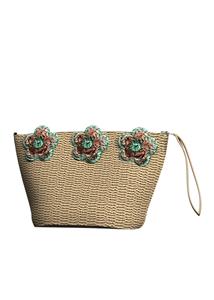How to Make a Crochet Bag Sturdy: 10 Expert Tips
How to Make a Crochet Bag Sturdy: 10 Expert Tips

Making a crochet bag that keeps its shape and withstands daily use needs specific techniques and materials. Crochet enthusiasts often find that sturdy bag-making techniques create functional, long-lasting accessories that resist sagging and stretching.
Professional results come from selecting the right materials and applying proper reinforcement methods. This piece presents ten expert-tested techniques that cover everything from selecting sturdy yarn to adding structural support through lining and interfacing. Crafters will master the steps to prevent their crochet bags from stretching by learning proper stitch tension, blocking methods, and handle and strap reinforcement techniques.
Choose the Right Materials
Selecting the right materials creates a strong foundation for your crochet bag. The right choice of fibers and weights determines if your bag will keep its shape or stretch out with use.
1.Selecting sturdy yarn fibers
Natural fibers create durable crochet bags with superior strength and shape retention. Here are the most reliable options:
• Cotton and Linen: These fibers give excellent stability with minimal stretch that makes them perfect for everyday bags. Cotton offers superior strength and maintains washability with great color retention.
• Hemp and Jute: These eco-friendly alternatives deliver exceptional sturdiness and natural rigidity. Hemp particularly stands out because it needs less water to produce while matching cotton's durability.
2.Optimal yarn weights for bags
Yarn weight plays a significant role in determining a bag's structure. Most crochet bags that become a soaring win use medium weight (DK) or heavier yarns. Crafters should select these weights to ensure durability:
#3 Light/DK weight or above for standard totes
Worsted or bulky weight for bags requiring extra structure
Lighter weights only for foldable market bags
3.Reinforcing materials to think over
You can improve your bag's stability with several reinforcement options:
Multiple Strand Technique: A combination of two yarn strands creates a denser, more durable fabric. This method works best when you have cotton or linen yarns.
A firm thread can provide extra structure if you run it along the yarn while crocheting. The process works better with materials like fishing line or beading wire, but you should wear cotton gloves to protect your hands.
Use Proper Crochet Techniques
Durable bags that keep their shape and structure rely on proper crochet techniques. A bag's sturdiness improves substantially when crafters use the right combination of stitches, hook size, and tension control.
1.Tight stitches for added structure
A dense and sturdy fabric emerges from carefully chosen stitch patterns. Single crochet stands out as the most dependable choice that creates a tightly woven, nearly opaque fabric. Crafters can achieve maximum durability with these proven stitch techniques:
• Basic single crochet for traditional strength
• Split single crochet for a knit-like stability
• Moss stitch for solid structure with minimal stretch
• Linked stitches for reduced gaps
2.Recommended hook sizes
The right hook size selection is a vital factor to achieve desired sturdiness. Crafters achieve better results with a hook size smaller than typically recommended for their chosen yarn. To cite an instance, crafters who work with 8-ply cotton can create a denser, sturdier fabric by switching from a 5mm to a 4mm hook.
3.Tension tips for sturdiness
A consistent tension will help create a sturdy bag that holds its shape well. At the time you work the stitches, pull the tension slightly tighter than usual but don't "murder the yarn" by pulling too tight. The handles and straps need fishing line to provide exceptional stability because it can withstand heavy pressure. You should work the fishing line lengthwise along the strap since this direction resists stretching better than horizontal placement.
Your bag will turn out best if you work in continuous spirals instead of joining rounds. This creates a smooth structure and helps maintain even tension. These methods will give a bag that keeps its shape even with heavy items inside. The fishing line technique works especially well to reinforce straps. Tests show that reinforced straps stayed at their original 4-inch length under pressure, while straps without reinforcement stretched to 6 inches.
Add Structural Elements
Structural support elevates a simple crochet bag into a professional-quality accessory that retains its shape and functionality through extended use. The right reinforcement techniques make the bag sturdy and dependable enough to withstand daily wear and tear.
1.Lining options for support
The right lining material selection plays a significant role in bag stability. The lining weight should match the bag's weight to prevent stretching or tearing. Crafters can choose these materials to support their projects:
• Light-weight silk or cotton for delicate bags
• Medium-weight cotton for everyday totes
• Canvas or duck cloth for heavy-duty bags
2.Interfacing to increase rigidity
Interfacing adds everything in structure to crochet bags. Peltex 71F Single-Sided Fusible Ultra Firm Stabilizer provides excellent support while maintaining the bag's shape. The application of interfacing requires cutting pieces slightly smaller than the crocheted panels to ensure easy assembly. Multiple types of interfacing work best together:
Primary Layer: Fusible fleece for body and flexibility
Secondary Layer: Shape-flex for additional stability
Bottom Panel: Ultra-firm stabilizer for base support
3.Reinforcing bag handles and straps
Strong handle reinforcement stops stretching and makes bags last longer. Adult totes need about 70-75 chain stitches to create stable handles, while children's bags work best with 50 chains. You can secure the handles firmly by using a square-and-X stitching pattern.
Adding fishing line while crocheting will improve your strap's strength. Research shows that straps with fishing line keep their shape under pressure, unlike plain straps that stretch by a lot. The best results come from running the fishing line along the strap's length.
Apply Finishing Techniques
The right finishing techniques can turn a simple crochet bag into a professional-looking accessory with improved durability. A combination of blocking, stiffening, and felting methods will substantially improve your bag's structure and longevity.
1.Blocking methods for shaping
The perfect shape of crochet bags comes from blocking. Wet blocking requires soaking the bag in lukewarm water with a splash of wool wash that prevents felting for about 10 minutes. Steam blocking works better for synthetic fibers, but crafters need to watch the heat levels because too much heat can damage the fibers.
A plant mister dampens the fabric in spray blocking which gives you the best control while shaping. The bag needs rust-proof pins to hold its shape until it dries completely after any blocking method.
2.Stiffening agents and sprays
You can improve your bag's structure with these stiffening options:
• Commercial Starch: Available in spray form or dissolvable blocks
• Homemade Solution: Mix one teaspoon of cornstarch with a quarter cup each of cold and boiling water
• PVA Mixture: Combine equal parts PVA glue and water for a permanent stiffening effect
Starch-based solutions can yellow white items, so it's best to avoid using them on light-colored materials. Your bag needs to dry naturally without any adjustments to achieve the best results from evenly applied stiffening agents.
3.Felting wool bags for durability
Felting turns wool bags into sturdy accessories. The process involves washing the bag at 40 or 60 degrees Celsius with regular detergent, avoiding special wool-specific products. Heat and agitation make wool fibers mesh together and create a dense, firm fabric.
Make sure the wool is colorfast before you start felting. This technique works best with bags that need extra structure, as the felted fabric becomes much stiffer than the original crochet. The method creates seamless bags with a professional finish and better durability.
Conclusion
Creating sturdy crochet bags requires thoughtful material selection and precise technical execution. Cotton and hemp yarns paired with proper stitch tension and reinforcement methods will give you professional-quality bags that keep their shape with regular use. The combination of support elements, from fishing line reinforcement to carefully selected interfacing, prevents common problems like stretching and sagging in handmade bags.
These expert techniques elevate simple crochet projects into durable, practical accessories you can use daily. The maker's skill shines through with careful attention to finishing details, proper blocking and strategic stiffening. These proven methods help crochet enthusiasts craft bags that blend esthetic appeal with lasting functionality.
FAQs
1.How can I reinforce the handles of a crochet bag?
To strengthen crochet bag handles, you can weave the tail end of a fishing line through several stitches, similar to how you would secure any end in a crochet project. For additional security, you might consider tying the fishing line directly to the bag's body, ensuring a durable, non-stretchy strap.
2.What techniques can I use to make my crochet more sturdy?
To make your crochet fabric more robust, consider using a stiffening liquid. Various solutions can be used, including starch, corn starch, a sugar solution, or a mixture of glue and water at a 50/50 ratio. These solutions help to chemically firm up the fabric.
3.What are some tips for making bags more sturdy?
For crafting sturdy bags, consider these top tips: select strong hardware, use heavy-duty fabrics like leather or vinyl, opt for coated fabrics for durability, choose a heavy interfacing, use thick thread, reinforce your stitching and seams, and sew with strong needles.
4.How can I prevent my crochet bag from sagging?
To avoid sagging in a crochet bag, using a round base is effective. Crochet stitches naturally stretch, and a round base helps distribute the weight evenly, maintaining the bag's shape even when filled.
5.How can I make a completed crochet bag more sturdy?
If your crochet bag tends to stretch or droop when filled, consider adding a lining or using a stiffening agent for reinforcement. For future projects, incorporating these materials during the crafting process can prevent such issues, ensuring a more durable finish.




